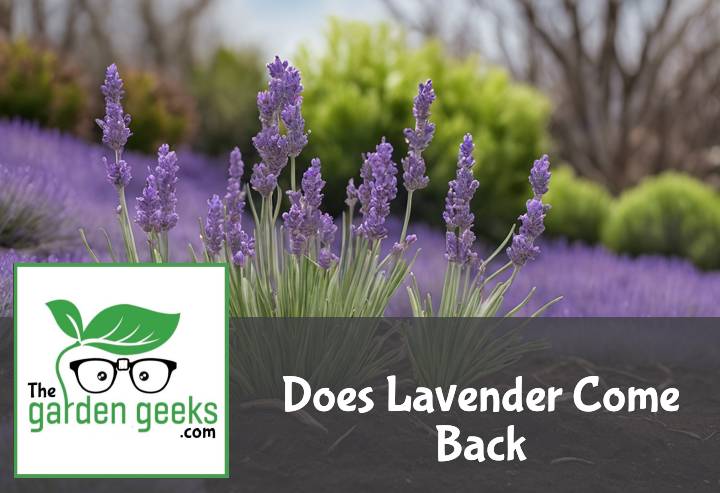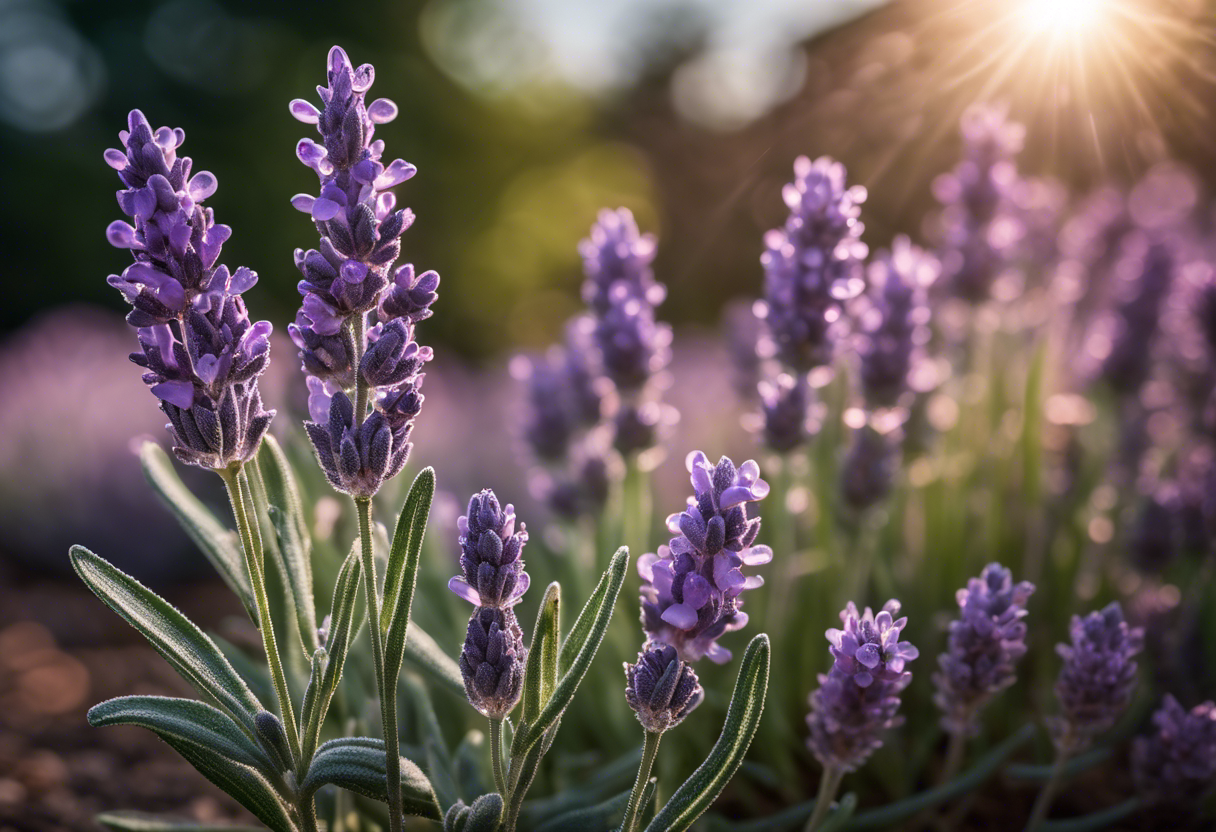Ever found yourself in the garden, hands buried in the soil, wondering Does Lavender Come Back each year? You’re not alone. I remember having the same question when I first started my gardening journey.
In this blog post, we’ll dig into this query and unravel the mystery that is lavender’s life cycle. So tighten your gardening gloves and prepare to get a little dirty as we delve into the world of lavender! Keep reading about ‘Does Lavender Come Back?’
Key Takeaways
- Lavender is a perennial plant, meaning it can come back year after year under the right conditions.
- The plant’s survival largely depends on the specific variety of lavender and the climate in which it’s grown.
- In colder climates, some varieties may require winter protection or indoor overwintering.
- Proper care including well-drained soil, full sun exposure, and good air circulation can enhance lavender’s chances of returning each year.
What is Lavender?
Ah, Lavender! This delightful plant has a lot to offer. Known for its vibrant purple hue and soothing scent, it’s a favorite among gardeners and nature lovers alike. Not just pretty to look at, lavender has a myriad of uses too – from culinary delights to therapeutic oils. In this article, we’re going to dive into the world of lavender, exploring its characteristics and the different types that exist.
Understanding Lavender
When you think about features of Lavender, what comes to mind? For most folks, it’s the stunning purple flowers that steal the show. But there’s more than meets the eye with this plant. It’s got silvery-green foliage that adds contrast and depth in any garden setting.
Next up is the smell – oh boy! The smell of Lavender is something else! It’s calming and soothing, often used in aromatherapy for relaxation purposes.
And let’s not forget about its growth habits. The growth habits of Lavender are quite interesting too! It loves basking in full sun and prefers well-drained soil conditions.
Types of Lavender
Now onto the types of Lavender plants. You see, there isn’t just one kind of lavender – no siree! There’s a whole variety out there waiting to be discovered.
You’ve got your English lavenders, known for their hardiness and sweet aroma. Then there are French lavenders with their distinctive butterfly-like petals. And let’s not forget about Spanish lavenders that thrive in hot climates!
Each type brings something unique to the table (or should we say garden?), adding diversity and interest wherever they’re planted. So next time you’re thinking about adding some lavender to your green space, remember – there’s a whole world of different kinds of lavenders out there just waiting for you!
Does Lavender Come Back Every Year?
Well, the answer to “Does Lavender Come Back” is a resounding yes! Lavender is indeed a lavender perennial plant. This means it’s got the stamina to return each year, adding its lovely purple hue and calming scent to your garden annually.
Lifespan of Lavender
Now let’s talk about how long this beauty sticks around. Under ideal conditions, the lavender plant lifespan can stretch up to 10 years or more. That’s a decade of fragrant blooms! The longevity of lavender isn’t just hearsay; it’s backed by green thumbs worldwide.
But remember, it’s not just about survival; it’s also about thriving. So, how long does lavender live in full bloom? Well, once established, your lavender bush will typically flower for several months each summer. Yes, you heard right! The flowering period of lavender can last from June until August.
Factors Affecting Lavender’s Return
Alrighty then, now that we know lavender is a comeback kid and has quite the lifespan let’s delve into what affects its return. There are several factors that influence whether your returning lavender plants will make their annual appearance or decide to skip a year.
First off, climate plays a big role in the lavender yearly growth cycle. These plants love themselves some sunshine and well-drained soil. So if you’re living somewhere with heavy rainfall or freezing winters, your lavenders might struggle.
Secondly, your care routine matters too. Regular pruning and proper watering can ensure your perennial lavenders stay healthy and ready to regrow each spring.
Lastly but definitely not leastly (is that even a word?), soil condition is crucial for lavenders’ return. They prefer slightly alkaline soil with good drainage – no waterlogged roots for these guys! So, keep an eye on your soil’s pH level and water drainage to ensure a happy return for your lavender each year.
How Does Lavender Regrow?
When it comes to lavender regrowth, there’s a bit of magic in the process. It’s like watching a phoenix rise from its ashes, only less fiery and more…well, lavender-y. Let’s dive into the details.
The Growth Cycle of Lavender
So, how does this whole lavender plant life cycle work? Well, it all starts with germination. Those little seeds sprout and start their journey to become full-grown plants. This is the lavender germination stage.
Next up is the growth phase where our little lavender seedlings stretch their stems towards the sky. They’re reaching for maturity now, entering what we call the lavender maturity stage.
But wait! What happens when winter comes knocking? Our lavender plants go into hibernation mode. They’re not dead; they’re just sleeping. This is what we call dormant lavender plants.
Conditions for Optimal Growth
Now that you know how lavender grows, let’s talk about creating the perfect environment for it. First off, soil – not just any dirt will do! Ideal soil for lavender should be well-draining and slightly alkaline.
Sunlight is another crucial factor in this equation. Lavenders love basking in the sun! So make sure your plants get plenty of it. We’re talking about at least 6 hours a day – that’s the optimal sunlight needs for lavender.
And lastly, water – but don’t go overboard! Lavenders prefer being on the drier side than being waterlogged. So remember: when it comes to watering lavender plants, less is often more!
Can All Varieties of Lavender Come Back?
When it comes to the question, Does Lavender Come Back, the answer isn’t a simple yes or no. It’s more like, “Well, it depends.” You see, there are different types of lavender out there. Some are perennial and others are annual.
Perennial vs Annual Varieties
Perennial lavenders are the tough guys in the lavender world. They’re like that one friend who always shows up at your parties, year after year. These plants have got some serious staying power! They can survive through winter and come back in spring, ready to bloom again.
On the other hand, we’ve got annual lavenders. These guys are more of a one-hit-wonder type deal. They bloom for a season and then say their goodbyes. So when you ask about lavender regrowth, it really depends on whether you’re dealing with a perennial or an annual variety.
Specific Varieties and Their Lifespans
Now let’s talk about some specific varieties of lavender and their lifespans. For instance, English lavender is a perennial type that can live up to 15 years if taken care of properly! That’s quite impressive for a plant!
Then we have French lavender which is generally treated as an annual but can last up to 5 years in warmer climates. So you see, even within the same family of plants, there’s quite a bit of variation when it comes to longevity and returning capabilities.
So next time someone asks you “Does Lavender Come Back“, you’ll know exactly what to tell them!
How to Encourage Your Lavender to Come Back Each Year?
So, you’re wondering, “Does Lavender Come Back each year?” Well, it’s all about the love you give your lavender! Proper lavender care, including the right lavender planting techniques, can make your perennial lavender return every year. We’ll dive into some essential lavender maintenance tips and ways of encouraging lavender growth.
Proper Planting Techniques
Now, let’s talk dirt. Or rather, soil. The right soil requirements for lavender are crucial. You see, these purple beauties prefer well-draining soil with a neutral to slightly alkaline pH.
Next up is sunlight. A lot of it! Yes, indeed – sunlight for lavender is like coffee for us humans; they need it to thrive! So be sure to pick a sunny spot in your garden.
Lastly, don’t forget about spacing. Giving your lavender plants enough space ensures they get proper air circulation and helps prevent diseases.
Maintenance and Care Tips
Alrighty then! Now that we’ve got planting down pat, let’s move on to maintenance. First off: water. When it comes to watering lavender plants, less is more! They’re pretty drought-resistant once established.
Pruning? Yes please! Regularly pruning your lavender bushes encourages new growth and keeps them looking neat and tidy.
And lastly – pests. Nobody likes ’em but they do love our lavenders unfortunately. Fear not though – there are plenty of ways for effectively controlling pests in lavenders without resorting to harsh chemicals.
Common Problems Preventing Lavender from Coming Back
You might be wondering, “Does Lavender Come Back?” Well, it should. But sometimes, lavender plants face a few hiccups that can prevent them from regrowing. We’re talking about diseases and pests, as well as environmental stressors. These are the usual suspects when it comes to preventing lavender regrowth.
Disease and Pests
First off, let’s talk about lavender diseases and pests. These little buggers can wreak havoc on your precious lavenders. Fungal diseases like root rot can cause serious lavender plant problems, making it difficult for the plant to bounce back.
Moreover, pests like aphids or whiteflies can also pose a significant threat to your lavender plants. They suck the life out of your plants (literally), hindering their growth. So, if you want your lavenders to flourish year after year, you might want to consider some effective disease prevention in lavenders and pest control for lavenders strategies.
Environmental Stressors
Next up are environmental stressors. Now these are tricky because they’re not always within our control. Factors such as extreme weather conditions or poor soil quality can put considerable environmental stress on lavenders, affecting their ability to regenerate.
For instance, lavenders aren’t big fans of waterlogged soils or extremely cold temperatures. They prefer well-drained soil and lots of sunshine! So if you’re dealing with less-than-ideal weather or soil conditions for lavenders, your plants might struggle to come back each year.
Remember folks, understanding these issues is key to ensuring that your lavender keeps coming back season after season!
To Wrap Up
So, like a well-loved sitcom with multiple seasons, we can confirm that yes, Does Lavender Come Back indeed. It’s not a one-hit wonder; it’s more of an encore performer in your garden.
Just remember to treat it right – give it some sunshine, good drainage and it’ll be back year after year like your favorite TV show. Happy lavender growing!





